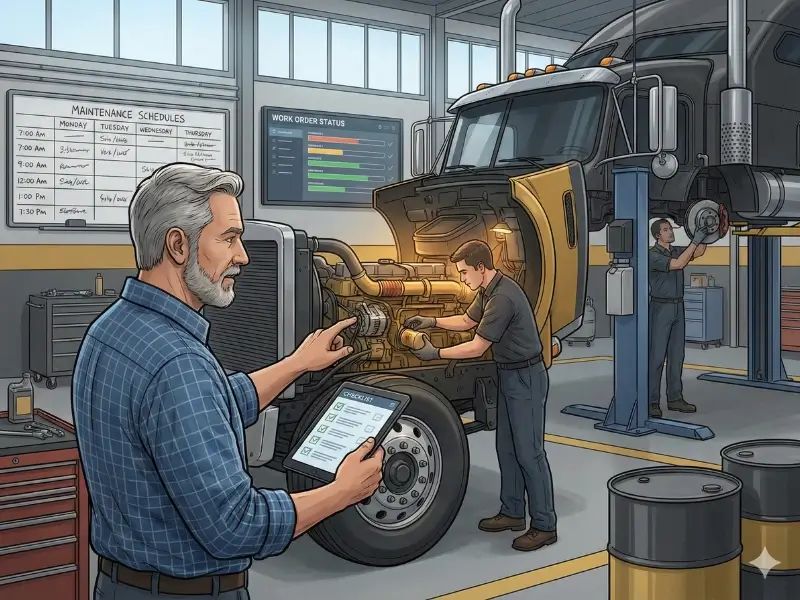Key Takeaways
- Regular maintenance of tools and equipment ensures safety, reliability, and cost savings.
- Preventive care reduces breakdowns and extends the lifespan of tools and machinery.
- Common issues include missed service schedules, scattered records, and costly downtime.
- Digital logs and analytics help identify underperforming assets and optimize maintenance budgets.
- Switching from manual to automated maintenance boosts efficiency, safety, and compliance.
In every successful fleet operation, tools and equipment form the backbone of performance, reliability, and safety. Whether managing vehicles, workshops, or heavy machinery, neglecting maintenance can lead to breakdowns, downtime, and costly replacements. That’s why having a structured plan for maintenance of tools and equipment is essential.
This guide explains why proper maintenance matters, what practices to follow, and how modern fleet management systems like Simply Fleet make the process simple, efficient, and data-driven.
Why Maintenance of Tools and Equipment Is Critical
Fleet operations depend on precision, timing, and reliability. Poorly maintained tools or equipment can cause cascading issues like delays in repairs, missed deadlines, and unnecessary expenses.
Here’s why consistent maintenance is vital:
- Improved Productivity: Well-functioning tools help technicians complete jobs faster and with greater accuracy.
- Cost Efficiency: Regular maintenance prevents major failures that could demand expensive replacements or repairs.
- Safety Assurance: Faulty tools increase the risk of workplace injuries and accidents. Maintenance ensures a safer working environment.
- Asset Longevity: Equipment that receives timely care and calibration lasts significantly longer.
- Regulatory Compliance: Many industries require proof of maintenance schedules to comply with safety and quality standards.
What are the Common Challenges in Managing Maintenance of Tools and Equipment?
Despite its importance, many businesses still struggle with equipment upkeep. Here are some frequent obstacles:
- Lack of Centralized Data: Maintenance records scattered across spreadsheets or paper logs make it difficult to track performance and usage.
- Missed Service Intervals: Without automated reminders, it’s easy to overlook scheduled maintenance.
- Unplanned Downtime: Reactive repairs often disrupt workflows and reduce productivity.
- Inventory Shortages: Running out of spare parts or lubricants can delay crucial maintenance tasks.
- Limited Visibility: Managers often don’t know which tools are in good condition and which require servicing.
To overcome these challenges, digital transformation through fleet management software becomes indispensable.
Best Practices for Maintenance of Tools and Equipment
A well-organized maintenance plan combines scheduling, monitoring, and optimization. Here are key practices that can dramatically improve your system:
Create a Maintenance Schedule
Establish a calendar for routine inspections, lubrication, part replacements, and calibration. Use metrics like mileage, usage hours, or time-based triggers to plan recurring tasks.
Standardize Maintenance Procedures
Every tool or equipment category should have defined maintenance steps. Document these protocols to ensure consistency, even when staff changes.
Track Tool Usage
Monitoring who used a tool, when, and for how long helps identify misuse or overuse. Tracking also enables fair allocation across teams and prevents unnecessary wear.
Maintain a Spare Parts Inventory
Keeping critical parts in stock prevents downtime. Fleet software with inventory modules can alert you when levels fall below a set threshold.
Train Your Technicians
Even the best tools fail without skilled handlers. Ensure every technician understands equipment operation and basic troubleshooting.
Use Digital Maintenance Logs
Replace paper records with digital logs to gain visibility and analytics. Cloud-based platforms make it easier to access data anytime, anywhere.
Monitor Equipment Performance
Use data analytics to track maintenance frequency, repair costs, and performance metrics. This helps identify underperforming assets and plan replacements proactively.
The Role of Fleet Management Software in Tool and Equipment Maintenance
Modern fleet management platforms like Simply Fleet automate and optimize maintenance workflows. Here’s how:
- Centralized Maintenance Dashboard: All maintenance tasks, records, and alerts are visible in one place. Managers can instantly see which equipment is due for service or overdue.
- Preventive Maintenance Scheduling: Simply Fleet lets you set preventive maintenance intervals based on time, mileage, or usage hours. Automated reminders ensure no task slips through the cracks.
- Real-Time Work Orders: Technicians can log issues directly from mobile devices. Work orders can be created, assigned, and closed digitally which saves time and reduces paperwork.
- Inventory and Parts Management: Track every spare part, lubricant, and consumable in real time. The system automatically updates inventory when items are used and notifies you before stockouts.
- Cost Tracking and Reporting: Understand the total cost of maintenance (labor, materials, and downtime) through detailed analytics. This helps fleet managers identify cost-saving opportunities.
- Mobile Accessibility: Whether you’re in the office or in the field, Simply Fleet’s mobile app allows you to monitor and manage maintenance activities on the go.
- Historical Maintenance Records: Access the full service history of every tool and piece of equipment. This helps during audits, resale, or warranty claims.
Key Benefits of a Digital Maintenance Approach
Switching from manual maintenance tracking to automated systems brings measurable benefits:
The difference is clear—digital maintenance not only saves time but directly improves your bottom line.
How to Implement a Maintenance Program for Tools and Equipment
Implementing a structured maintenance program may seem complex, but breaking it into stages makes it manageable.
Step 1: Assess Current Practices
Start by identifying which tools and equipment are critical to operations and how maintenance is currently tracked.
Step 2: Create an Inventory List
List every asset with details like serial number, purchase date, warranty, and maintenance requirements.
Step 3: Define Maintenance Frequency
Set intervals for routine servicing based on manufacturer recommendations and usage data.
Step 4: Choose the Right Fleet Management Platform
Select a software solution like Simply Fleet that supports maintenance scheduling, asset tracking, and reporting.
Step 5: Train Your Team
Ensure all users (from technicians to supervisors) understand how to use the platform effectively.
Step 6: Review and Optimize
Regularly analyze maintenance data to spot inefficiencies and improve processes over time.
Signs It’s Time to Upgrade Your Maintenance Process
- Frequent unexpected breakdowns
- Unclear equipment ownership or usage logs
- Rising repair and replacement costs
- Poor visibility into maintenance history
- Manual data entry causing errors
If any of these sound familiar, adopting a system like Simply Fleet can transform your maintenance workflow.
Download your FREE Heavy Equipment Checklist!
How Simply Fleet Makes Maintenance Simple
Simply Fleet offers a unified platform designed specifically for maintenance of tools and equipment across fleets and facilities. Its intuitive dashboard, automated reminders, and real-time analytics help teams stay ahead of maintenance needs.
Key Highlights:
- Schedule preventive maintenance automatically
- Assign and track work orders easily
- Monitor tool condition and usage trends
- Access reports that highlight performance and costs
- Manage everything from one cloud-based interface
Ready to Simplify Your Maintenance Operations?
Experience the future of equipment maintenance with Simply Fleet. Automate schedules, track costs, and extend the life of your assets effortlessly. Request a Demo or Talk to Our Team today and see how Simply Fleet can transform your maintenance process.



.png)








.png)


.png)


.webp)
%20(1)%20(1).webp)




